21 Aug 2017
Third-year veterinary student Rosana Caianiello looks at a study from The University of Edinburgh that revealed a link between a dog’s genes and the shape of its skull.

IMAGE: Fotolia/Andi.es.
Brachycephalic breeds should be labelled with a health warning – stenotic nares, elongated soft palate and everted laryngeal saccules are just the beginning of their problems1.
These health problems are related to the shape and length of their skull, but can also be blamed on their genes. It has been discovered flat-faced breeds have a genetic mutation, identified by researchers at The University of Edinburgh.

It is well known different dog breeds have come to exist through selective breeding over the past 200 years2. Selective breeding has created genetic diversity, leading to flat-faced breeds, such as pugs and bulldogs.
It has come to light flat-faced breeds have a genetic mutation3. According to a study from The University of Edinburgh, brachycephalics have a mutation that reduces secreted protein acidic and rich in cysteine-related modular calcium-binding protein 2 (SMOC2) gene expression3, reducing the length of these breeds’ faces.
The study analysed the skulls of 374 pure-bred and mixed-breed dogs, which included 84 breeds recognised by The Kennel Club. A CT scan was used to assess skull measurements and individual’s genes were used to assess the association with skull shape and length3.
This highlighted genes were linked to skull shape, including brachycephaly. On further investigation, it was found the SMOC2 gene was responsible for brachycephaly3. SMOC2 is involved in expression of the frontonasal process, maxillary and mandibular prominences3. In brachycephalics, this gene is mutated and has a premature stop codon3, causing the extreme face shape of flat-faced breeds, such as pugs.
The researchers stated the identification of the SMOC2 mutation could be a starting point for further investigation, as it affects the health of brachycephalics. Not only has this study highlighted how genetic mutation has led to the face shape of brachycephalics, but also demonstrates how the SMOC2 gene could be used to shed light on human head abnormalities that develop in the womb, aiding medical research3.